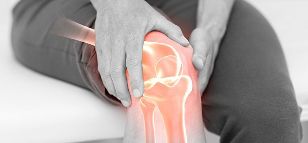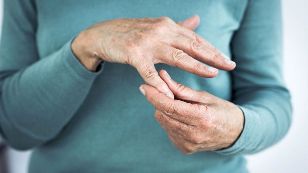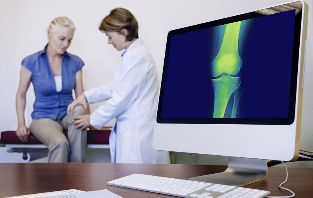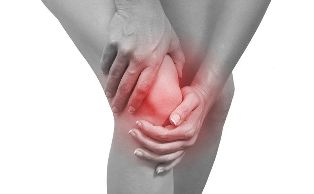Osteoarthritis is not an inflammatory disease of the joints, in which there is destructive-dystrophic processes, such as the defeat of the articular cartilage, ligaments and bones, pathological changes in the synovial membrane (or membrane) capsule and the articular (in the joint shell, hermetically closes it and which phenomena is a connection to the bones in the joint). When osteoarthritis pain is felt in the joint may limit mobility.

Causes of osteoarthritis
Yes, this hour is not precisely known, that phenomenon is the root cause of osteoarthritis, but there are several factors that worsen the condition of the joint, which change its structure and functioning. Push Yes osteoarthritis can serve as:
- trauma (sprains, torn ligaments, fractures, contusions, penetrating wounds);
- static and dynamic loads associated with professional activity (in athletes, dancers, miners and other persons engaged in heavy physical exertion);
- obesity (there is a constant stress on the joint);
- hypothermia;
- infectious diseases (tuberculosis, chlamydia, influenza);
- the blood circulation;
- hormonal changes (pregnancy, menopause, menopause);
- the metabolic (osteoporosis (reduced bone density), arthritis (inflammatory joint disease), gout (deposition of uric acid salts in the joints));
- autoimmune diseases (systemic lupus erythematosus (a disease in which the immune system recognizes its own cells as foreign and fights with them), rheumatoid arthritis (the immune system mistakenly invades the healthy joint));
- hemophilia (due to hemophilia frequent bleeding in the joints);
- disorders of the endocrine system (thyroid disease);
- degenerative changes (Perthes disease (aseptic necrotic process in the head of the hip joint), the necrotic process in which the cartilage separates the bones, and hell is moved into the joint cavity, causing necrosis of cancellous bone, resulting in formation of small fractures;
- congenital diseases (connective tissue dysplasia (improper formation of the tissue), hip dysplasia (abnormal development of the joint), congenital abnormalities of the upper and lower limbs);
- old age;
- intoxication (an overdose of drugs, excessive drinking, drugs);
- surgery on the joint;
- sedentary lifestyle;
- heredity;
- beriberi.
The degree of osteoarthritis
Process lesions of arthrosis is divided into 4 degrees:
-
The zero degree of osteoarthritis – an obvious morphological changes were observed, but the allusions to disease are already available. There is a change in the composition of the synovial fluid, so the power supply to the cartilage deteriorates, thus, its resistance and the load decreases. In the morning after awakening or after prolonged rest in a stationary state, there is difficulty in movement of joints, but the stiffness passes. This condition is called "starting pain". When movement a joint makes a crunching, but the pain during movement do not exist. For the first degree is characterized by pain after a long, hard load on the joint, Hello soreness disappears immediately after the break.
-
The first stage of osteoarthritis is the other degree is characterized by destruction of hyaline cartilage. Start morphological changes. X-ray shows the presence of newly formed osteophytes on the edges of the bone surface. The synovial capsule becomes thinner. It is noted narrowing of the joint space (a reduction in the distance between the heads of the bones of the joint). Muscle function have also been subjected to negative influence. Another degree of osteoarthritis the usual constant pain, a crunch of joints, hours claudication. It is noteworthy phenomenon is the emergence of a "mechanical pain", which occur when running, walking, exercises because of the reduction in cushioning cartilage.
-
Another degree of osteoarthritis articular cartilage is completely worn, observed extensive destruction. At this stage the disease is progressing rapidly. Characterized by a complete absence of synovial fluid, a sharp pain, atrophy of muscles, shortening of the ligaments, destruction of meniscus, the development of reactive synovitis (inflammation of the synovium, the formation of pus or fluid accumulation, increase joint). Here the limbs are deformed (X-shaped and O-shaped curvature of the legs). Almost disappears completely the joint space, deformed articular surface with large-scale growth of osteophytes. The range of motion is limited or becomes impossible. Phenomenon is the sensitivity and changes the weather (humidity, low temperature, high atmospheric pressure). The third stage of osteoarthritis tells about the disability.
-
The third stage of osteoarthritis – on the fourth degree of the disease of joint function lost. Phenomenon is such a phenomenon Java as a sudden sharp pain in the affected joint, which does not relieve drugs. Can occur ankylosis (fusing of bones), or false joint, which is formed in unusual place for him. The fourth degree of arthrosis evidence of disability. Treatment may mean only surgical intervention with the implantation of the prosthesis.

Types of arthritis
Osteoarthritis of the knee
Knee osteoarthritis is also the name of deforming arthrosis of the knee joint. The progression of osteoarthritis brings pain and further deforms the knee with possible increases in volume and inflammatory outcome.
In athletes the result of regular stress on the knees can develop what is known as osteoarthritis that affects the knee joint, pain is felt in the front of the affected knee, patella, may, pointed edge). Behind the pain is the crunching and clicking of the joint.
Osteoarthritis of the hip joint
Also known as osteoarthritis. This kind of arthritis severe and progresses faster than other types of this disease that leads to disability. Lesion in one hip (unilateral arthrosis) can lead to a defeat for the other (bilateral osteoarthritis). With a high probability, run existing arthrosis in the hip joints will cause damage to the knee joint and spine. There is a lameness, shortening of the affected limb, the rustling of atrophy of the thigh muscles.
uncovertebral arthrosis
When uncovertebra osteoarthritis suffers neck joint.
In addition to the above factors that cause attachment and phenomena phenomena of diseases of the joints, causes uncovertebra osteoarthritis can be a load on the cervical spine, osteochondrosis (degenerative changes in the vertebrae, cartilage, intervertebral discs and surrounding tissues), disc herniation (protrusion, bulging disc of the spine).
Osteoarthritis of the neck joint is accompanied by a decrease of cartilage, compaction and deformation processes of the cervical, decrease of space, bone growth in the hips the result of the narrow space in the cervical spine, compressed nerve roots and narrowing of the spinal canal.
For uncovertebral arthrosis characteristic symptoms headache, neck pain, dizziness, vomiting, low sensitivity of the neck or the sensation of ants in this region, increasing blood pressure.

Arthrosis of the jaw joint (TMJ)
TMJ – temporo-mandibular joint. The joint is closer to Yes of the ear, between the jaw and the forehead on both sides of the skull. The cartilage of the jaw joint is not as strong as in other connections, so his defeat causes severe pain. The disease is common among people aged 50 years hell, ill mostly women. The consequence of osteoarthritis of the temporomandibular joint the phenomenon is the difficulty in chewing food with pain, hearing loss, pain when talking. In this case, the causes of osteoarthritis are as follows: the change in the bite, congenital anomalies of the jaw, jaw injury, stress, unsuccessful treatment of teeth, damaged teeth, old age. By moving the jaw, is published click and crunch when you try to open your mouth the jaw may shift to the side.
Arthrosis of the elbow joint
This type of arthritis is less common other types of disease, as the load on the elbow joint is almost negligible. If there is inflammation of the localization of osteoarthritis is swollen and red, there is a click, creak, crunch with arm movement, a painful syndrome, the temperature rises slightly the whole.
Arthrosis of the foot
This type of arthritis is also known as coxarthrosis. Disease of the ankle joint is characterized by increased fatigue when walking, swelling (when connected inflammation in the process), pain (especially at night). Walking people feel the clicking in the ankle joint. In coxarthrosis injuries affect the joints, muscles, tendons, nerves and blood vessels. The weakening of the tendons causes subluxation (the joint surfaces are partially in contact). When dislocation of the articular profile in google + are completely inconsistent.
The symptoms of osteoarthritis
In the early stages of arthritis symptoms may not bother you, but Dalia, the disease is gaining speed and are detected first and subsequent signs. The main symptom of arthrosis of the phenomenon of pain is based on ad site of lesion (in the jaw and neck, shoulders, spine, elbows, wrists, fingers and legs, tribes, hip, and ankle joint). Pains are dull in nature, but with intense passages of the disease will increase and become unbearable. The main symptoms of osteoarthritis:
- starting pain (joint stiffness after sleep or rest, which runs during the day);
- mechanical pain (occurs after work, stress, running, exercises, walks);
- night pain (venous stasis provokes pain at night);
- weather dependent (change the weather, I worsen the condition);
- crunching, creaking, crackling or uncharacteristic, clicking in the joint;
- limited mobility;
- deformity of the affected joints;
- cramps, unpleasant muscle spasms;
- lameness;
- redness and swelling at the site of affected joint (if additional inflammation).
Diagnosis of osteoarthritis
Self-diagnosis of "arthritis" do not deliver. With a bothering pain, crunching in the joint should be treated first so the therapist. He will examine the patient and give the direction and the right doctor, orthopedist, traumatologist, a rheumatologist, a surgeon or neurologist.
Arthritis diagnose a podiatrist. Before examination, the doctor collects the anamnesis (information about the patient, hereditary or chronic disease), and doing a review. The patient is then sent for examination.
Laboratory examination
In the diagnosis of osteoarthritis may need these tests:
- General analysis of blood (blood from finger);
- biochemical analysis of blood (rheumatology test, a raft of blood from the veins);
- urine;
- analysis of synovial fluid or puncture of the patient's joint (the raft by means of the injection into the joint).
Instrumental diagnostics
X – ray- this study will show the stage of arthrosis, the slightest changes in the structure of the joint and deformation using x-rays. Before the examination the patient has to remove jewelry so as not to distort the result in the picture. You need to remove the clothes from that part of the whole that will be examined (if you need an x-ray of the knee, you need to remove the pants; the gypsum is not removed). Then the doctor says what position you need to take to images of the patient area. At the time of diagnosis the patient is served a lead apron toward the groin, and the area of the thyroid gland, an apron to prevent the passage of these designated x-ray radiation. Then the picture is taken.
The x-ray beam passes through soft tissue but is absorbed by the solids (bones, teeth). Therefore, the soft tissue on x-ray is obtained of a dark color, and solid fabric light. X-ray is the best diagnostic method of bone tissue, as reflected in the pictures of good bones and joints.
CT (computed tomography) – a method of radiological diagnosis that indicates the organ, bone or tissue at the incision in layers. CT is performed when x-rays are insufficiently informative and the arthritis cannot be determined. The procedure is performed within a few minutes. The patient lies on a table after removing clothing and metal jewelry. Then a ring of detectors (scanner) rotates around the reclining patient, and snapshots. Lying during the CT scan have still.
MRI (magnetic resonance imaging) – a method of radiological diagnosis. You'll be a hell of KT that better distinguish soft tissue, but not distinguished by the presence of calcium in the bones, in contrast to the hell of a CT scan that examines bone tissue. MRI in osteoarthritis assigned to learn more AB camp nearby tissues or to investigate the cause of the disease. Diagnosis using MRI is expensive, but informative.

Sonography (ultrasound) is a safe non-invasive method, without radiation and harmful substances. The doctor moves the transducer over the problem area and the screen shows the internal structure of the joint. This method of diagnosis of osteoarthritis of affordable, safe and informative.
Forecast
Osteoarthritis may a good prognosis when it comes to the life of the patient, the disease is not fatal, but complications can lead to disability. However, to completely recover a hell of osteoarthritis is impossible, since the age of disruption is faster than the recovery of damaged areas. The disease progresses slowly and can develop for decades. Finding the first signs of osteoarthritis can slow down further deformity and dysfunction of the joint with treatment at the initial stage.
Prevention
Often result in uneven, unnecessary stress suffer knee and hip joints, so you need to calculate the power load and to get rid of the hell of excess weight, if any to make the joints work properly and smoothly.

















































